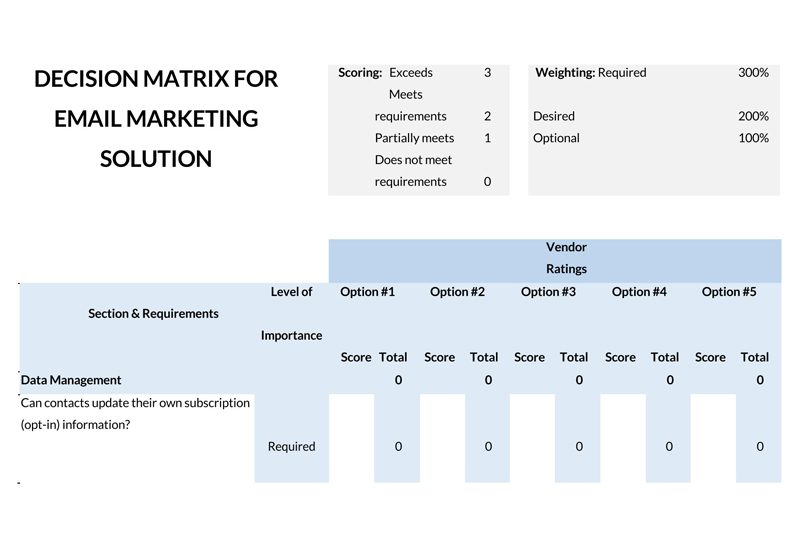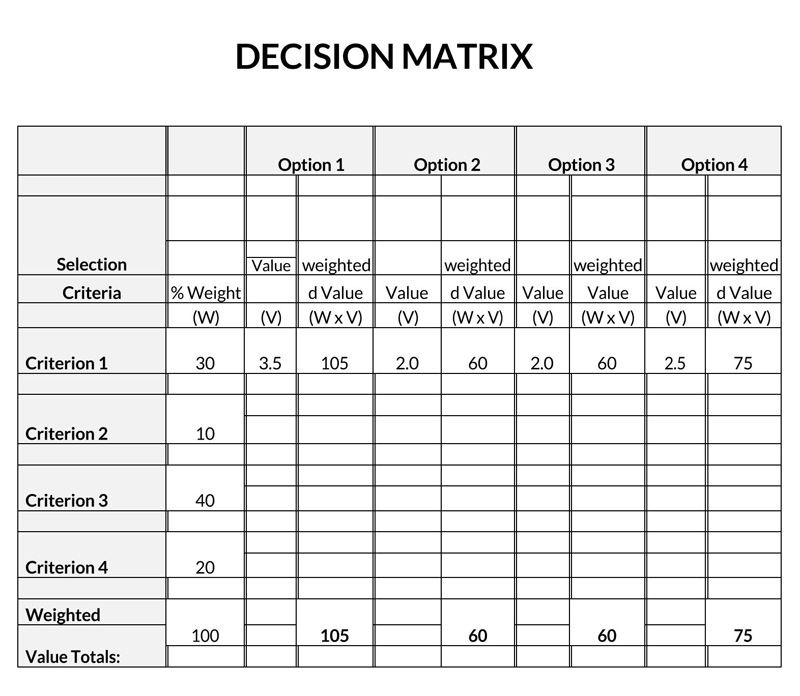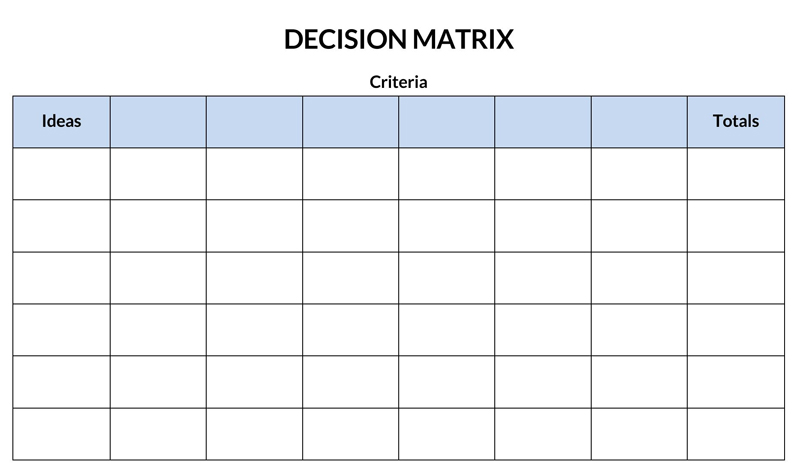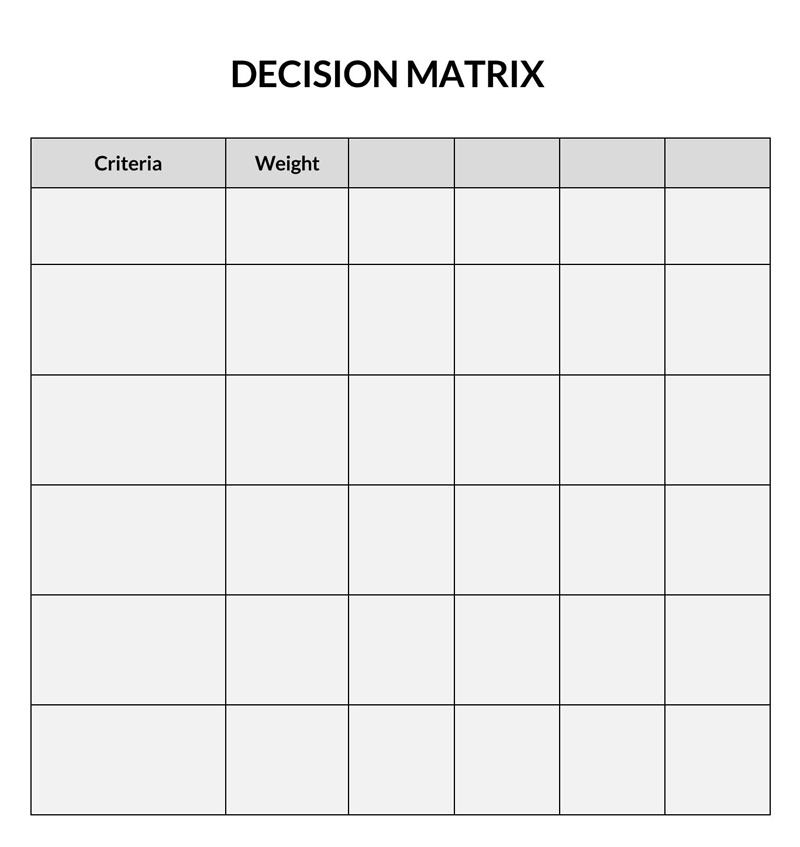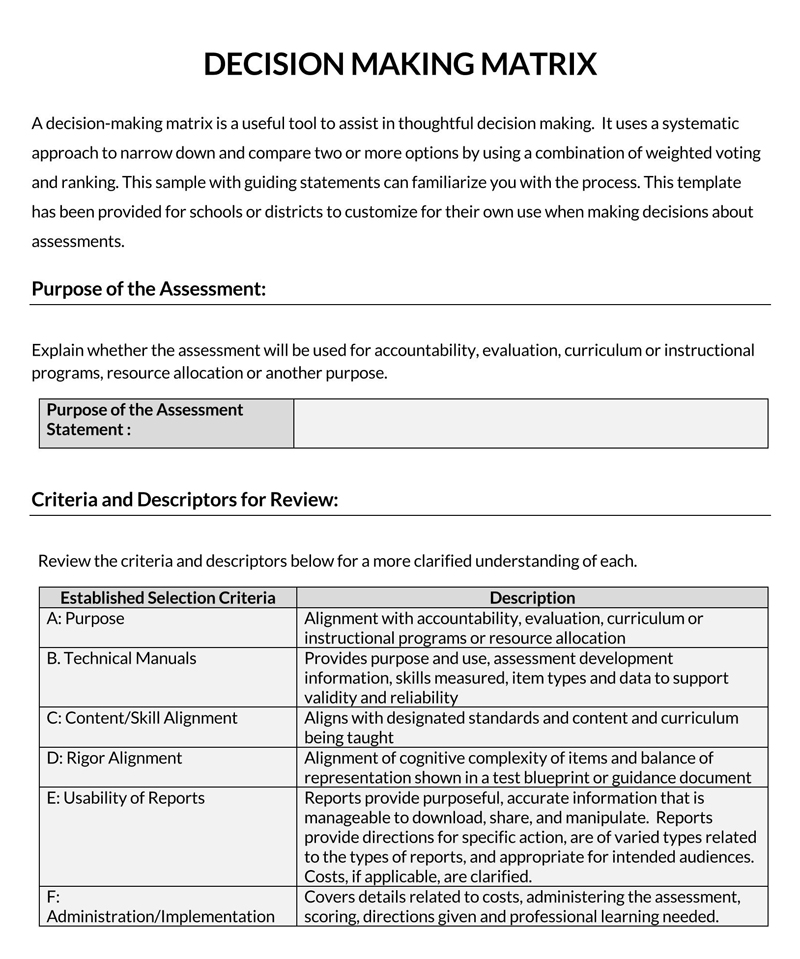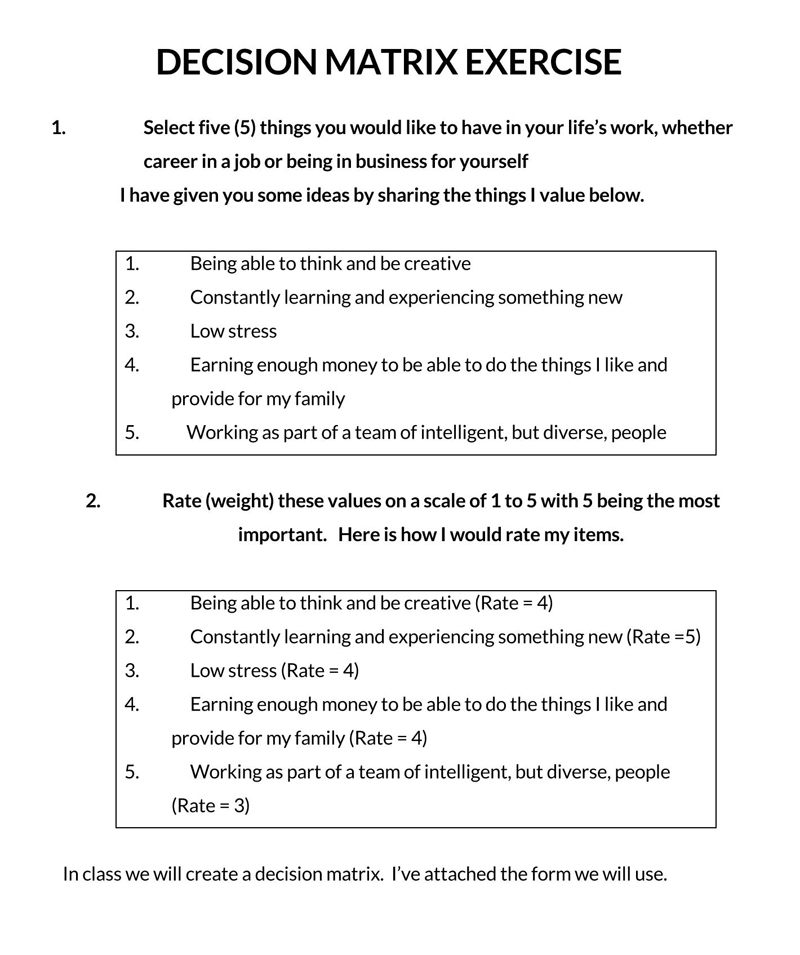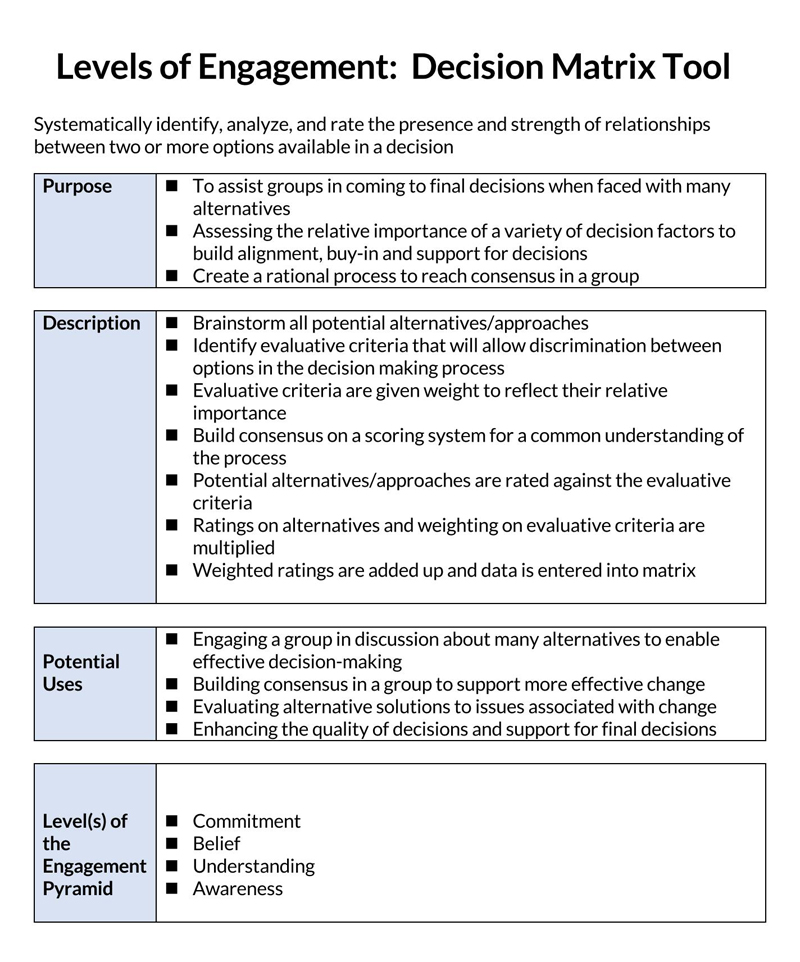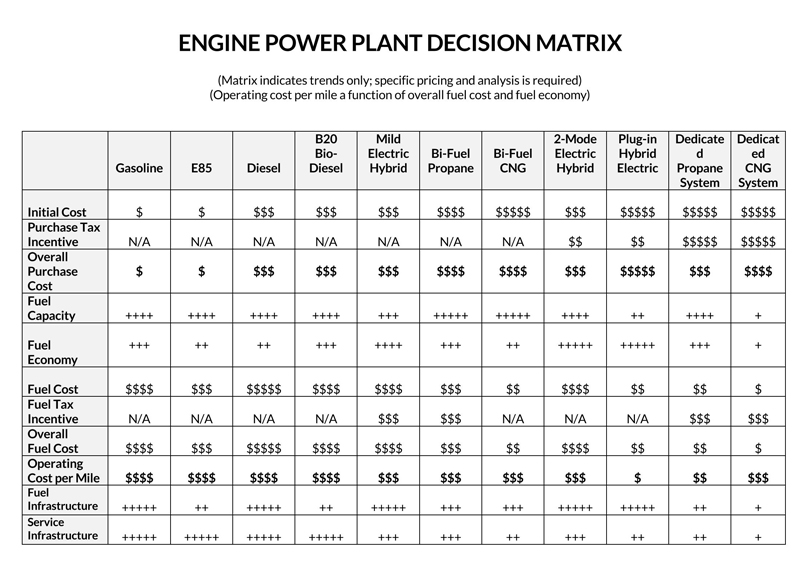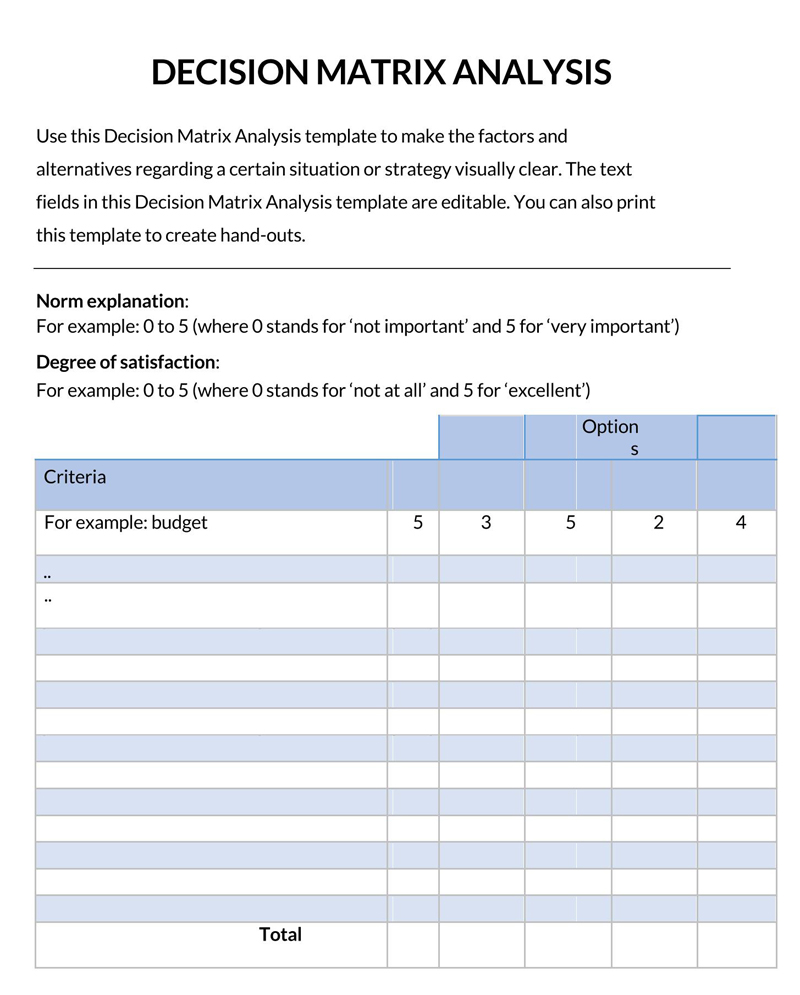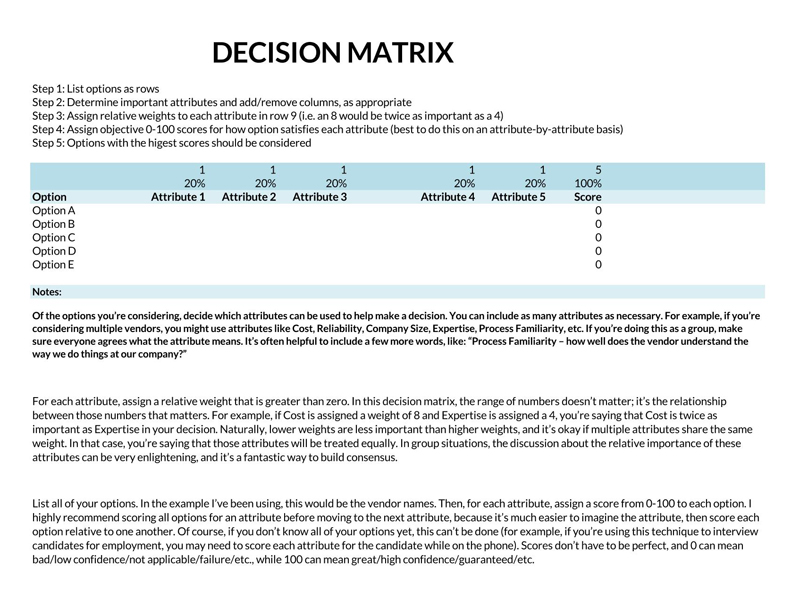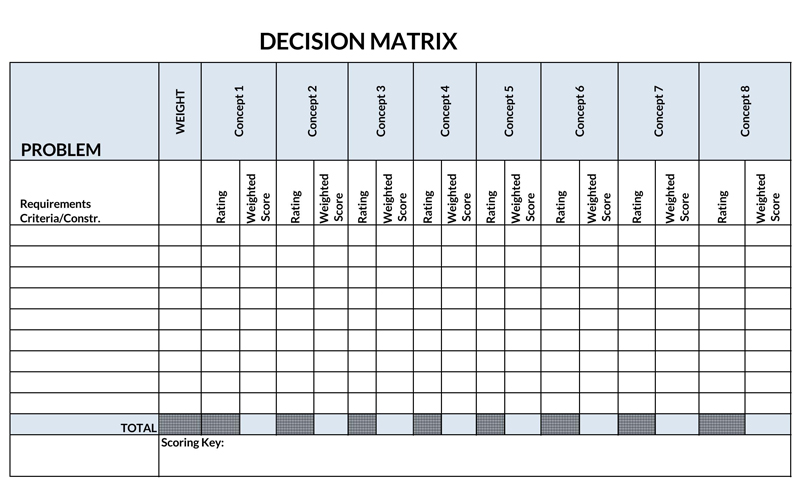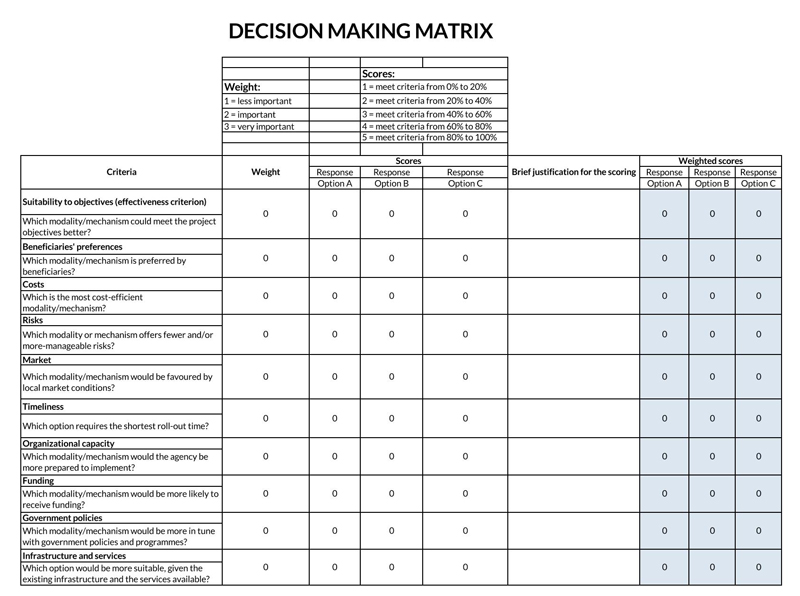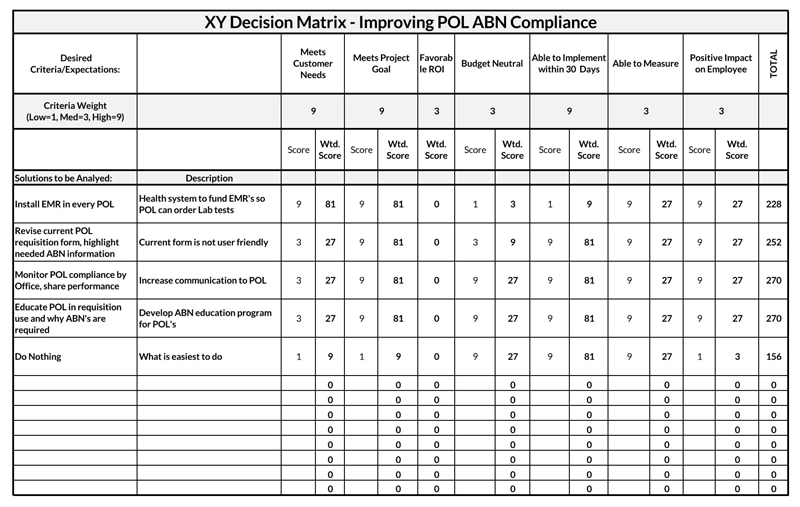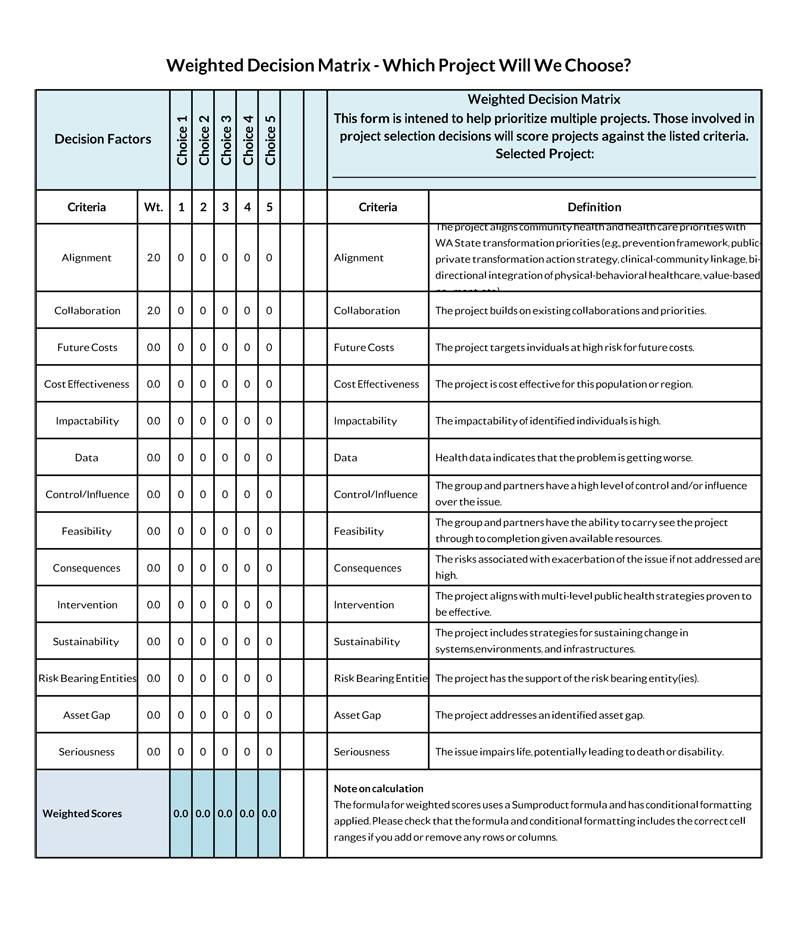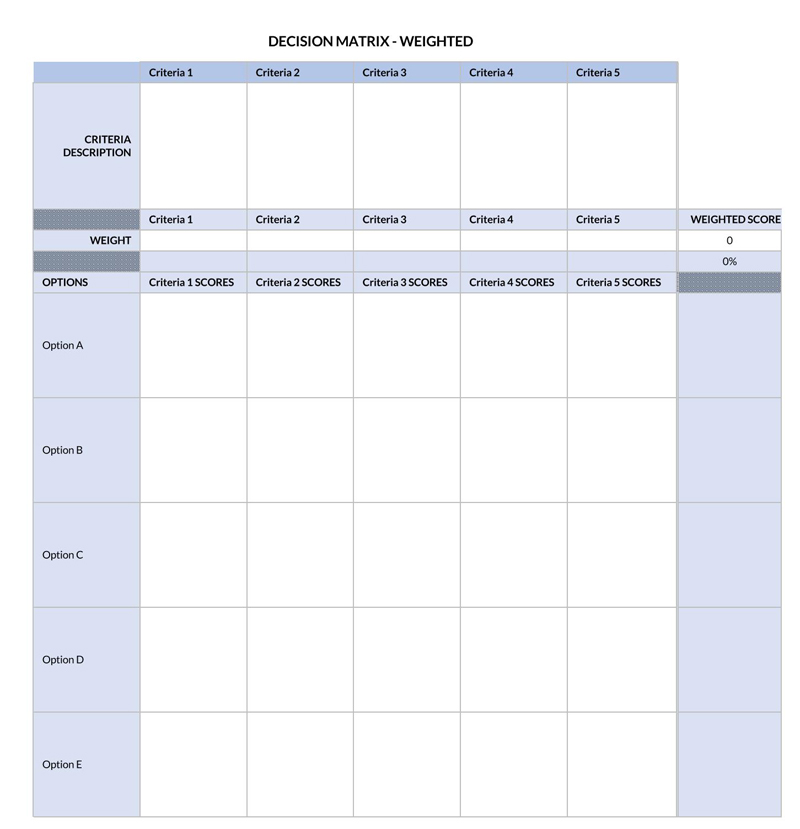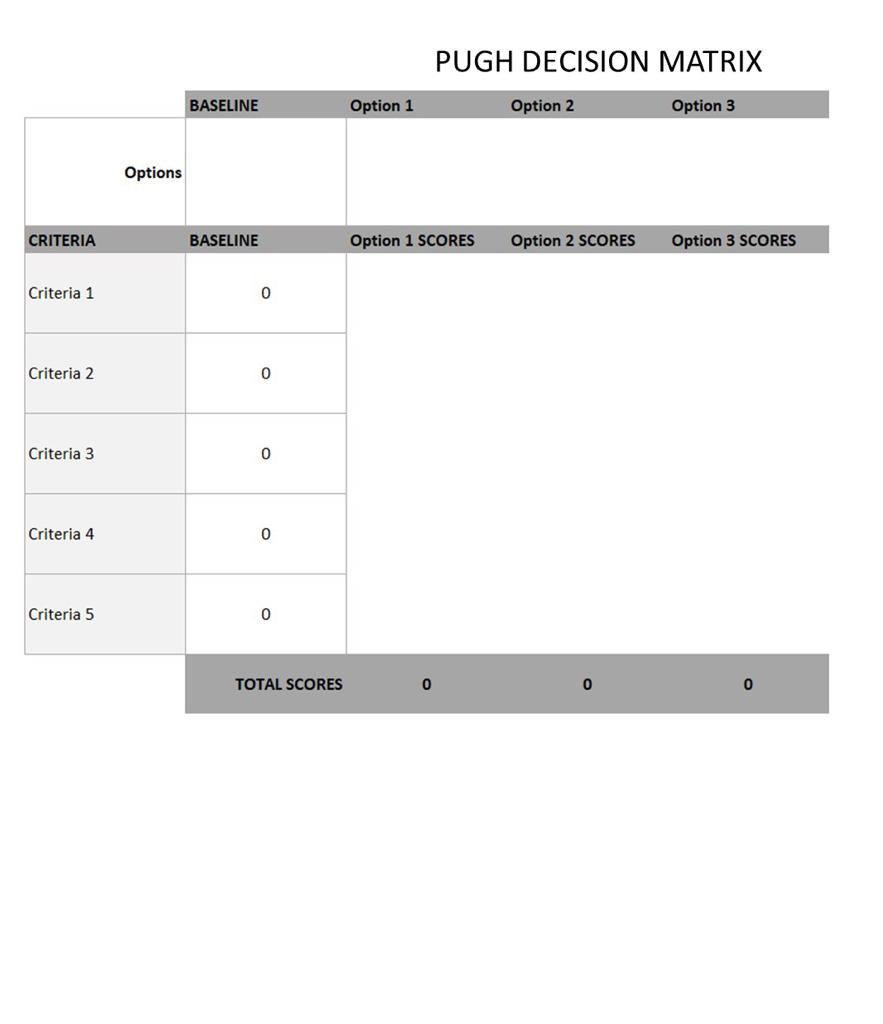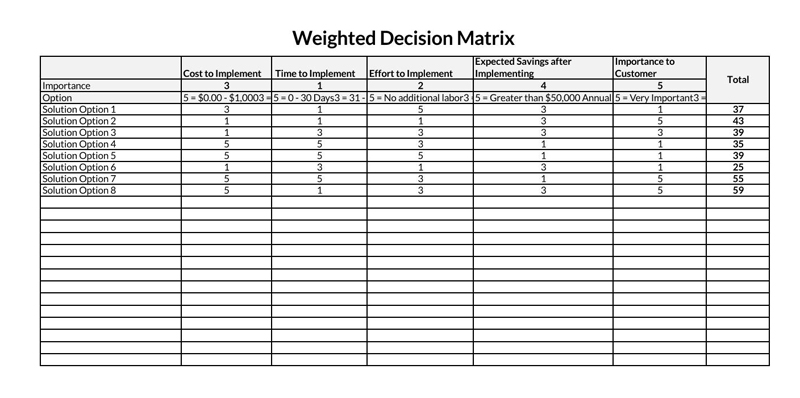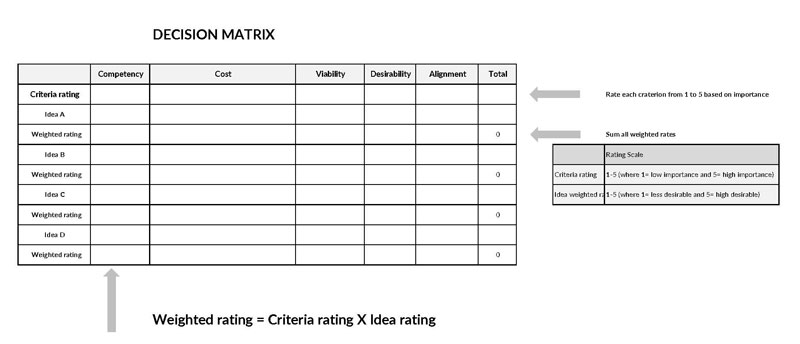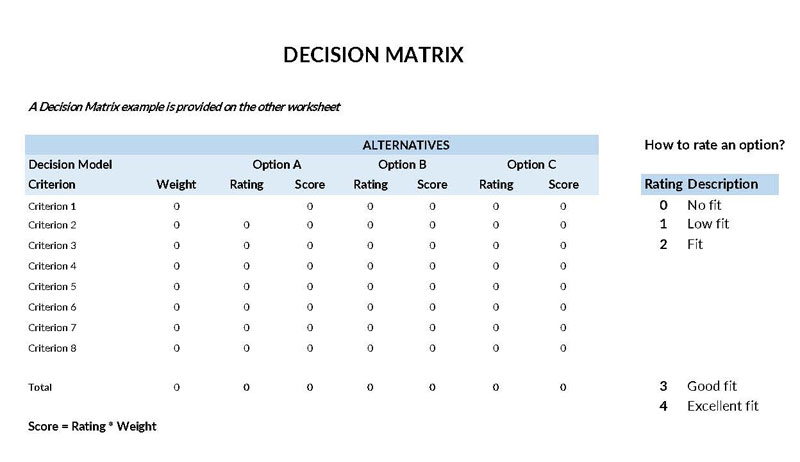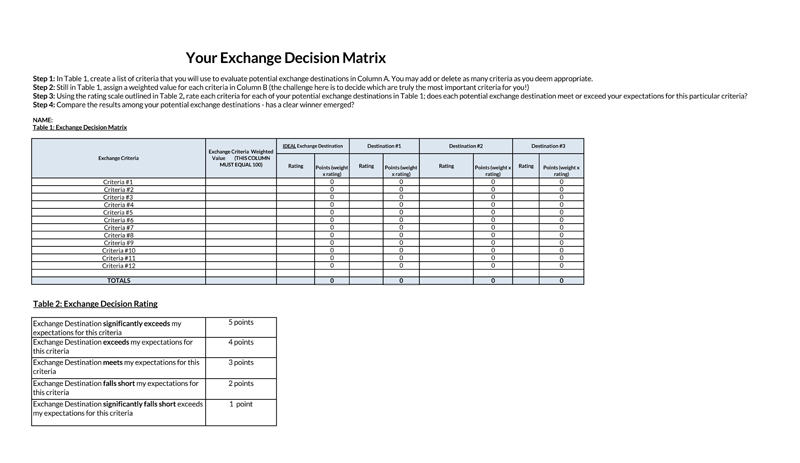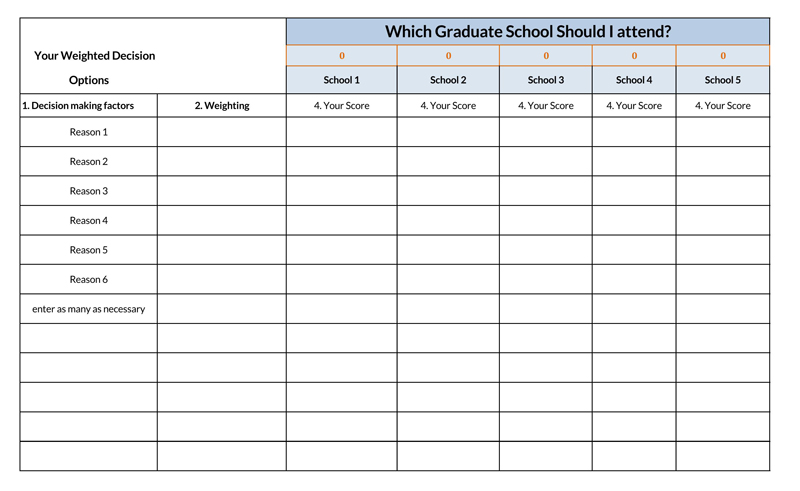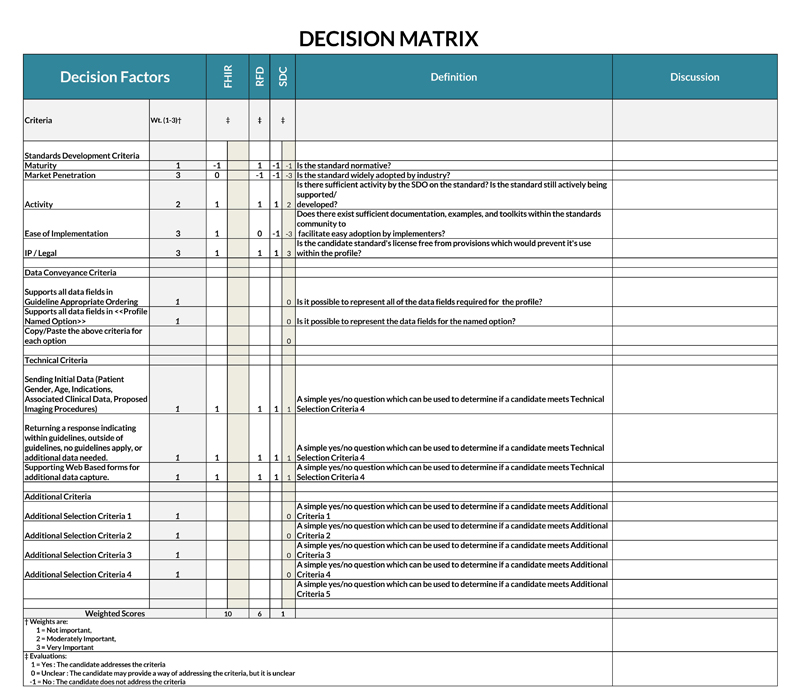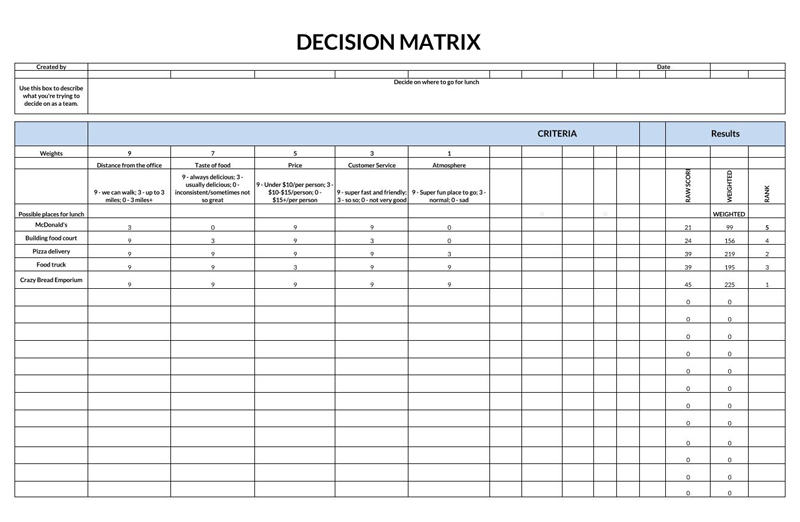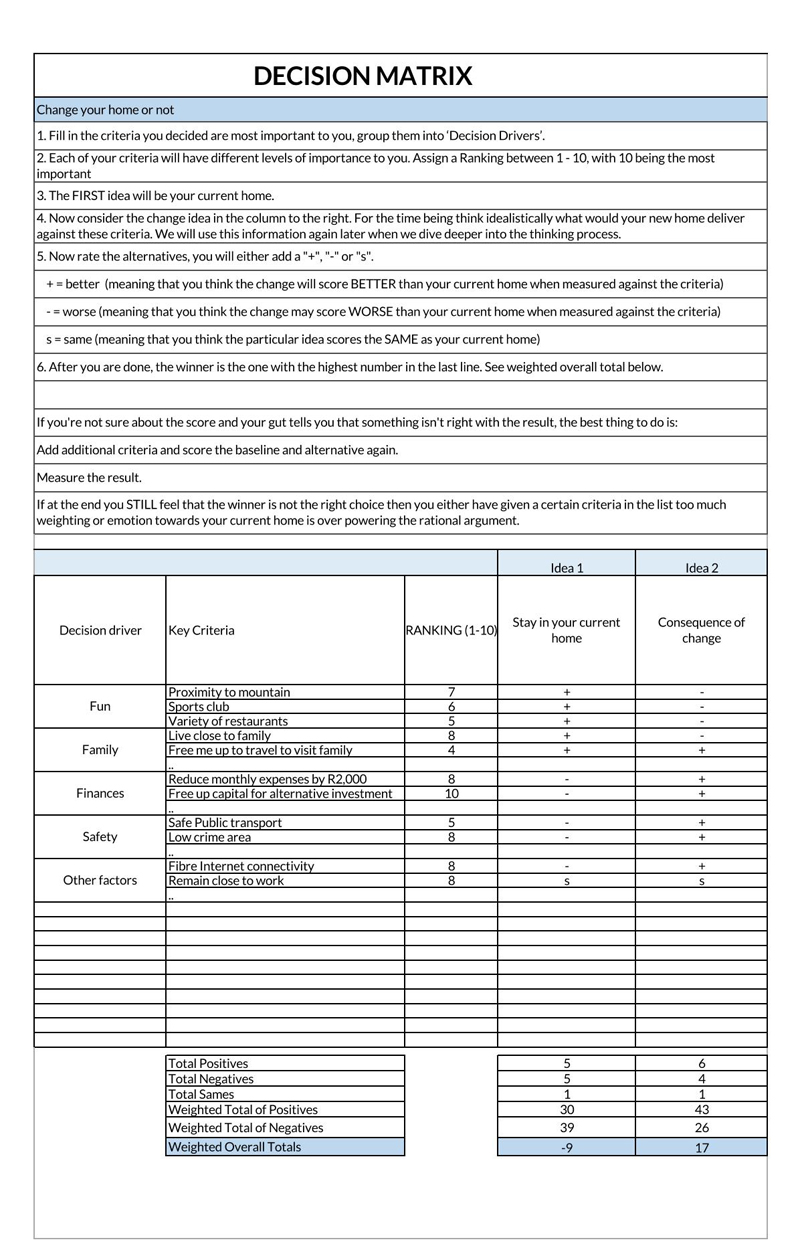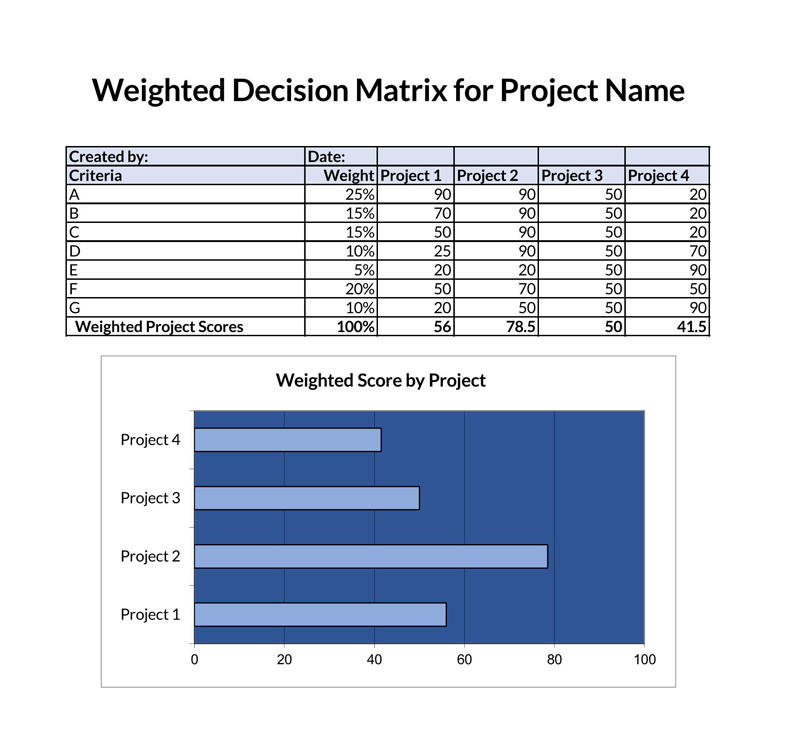A decision matrix is a decision-making tool used to evaluate, prioritize, and sort out alternatives/choices. It is also referred to as a grid. Through the matrix, individuals and entities use set criteria to develop solutions/decisions that are objective to arrive at the best or optimal course of action.
This way, multi-criteria decision analyses (MCDA) can be done with decision matrices. The matrix highlights the key factors affecting or influencing a decision and ranks them based on their importance.
The matrix offers the benefits of reducing the decision-making process fatigue, clarifying, and prioritizing options, and reducing subjectivity in decision-making. Through decision matrices, decision-makers or analysts are able to systematically evaluate their options.
A decision matrix is alternatively referred to as:
- Pugh matrix
- Selection matrix or grid
- Decision grid
- Solution matrix
- Multi-attribute utility theory
- Criteria rating form
- Criteria rating form
- Problem matrix
- Problem selection matrix
- Opportunity analysis
- Solution matrix criteria-based matrix
Decision Matrix Template
There are different ways of creating the matrix that vary in complexity and preference. However, the following methods can be used to make effective decision matrices.
By using paper
The matrix can be handwritten on a piece of paper, whiteboard, or spreadsheet where one writes down all the relevant details needed for the execution of the matrix.
Ready-made decision matrix
Also, you can opt to use readily available templates. You can download and input all the relevant details to use in the matrix. The templates are designed with features such as conditional formatting, data linking, and customization.
Variations of a Decision Matrix
There are two variations of decision matrices.
They are:
- Weighted: A weighted matrix assigns a number/numerical value to each factor affecting the decision, and its value (weight) is dependent on the impact of the factor on the final decision. The greater the importance or influence (weight), the higher the numerical value.
- Unweighted: An unweighted matrix assumes that all the factors have equal influence in the final decision and hence have the same value in the decision-making process.
Items Needed for a Decision Matrix
To incorporate the matrix in making suitable decisions, there are several items that you ought to consider. These items will often require sufficient research and planning to determine.
They include:
Well-defined criteria
The criteria to be used in the matrix should be specific and objective. There should be a well-defined relationship between the influence/impact of criteria and the decision to be made. Also, no criterion should overlap with another criterion.
Weights
The factors/criteria should be weighted. This way, the factors are identified in order of influence/impact. Consequently, this ensures that more important factors are prioritized and hence have a more significant impact on the outcome of the matrix.
Well-defined options
The alternatives/options for consideration should be precisely defined. The options should be rational and within the margins of fulfillment.
EXAMPLE
If the objective is to have more work done in 24 hours, it is more rational to increase workers than increase working hours for each worker. Or, if the goal is to buy a TV set, providing the type/brand, screen size, resolution, and version details can specify the option.
A scale
A scale should classify things/considerations in order of importance – very important, slightly important, or not important. A scale can be 1-3, 1-5, 1-10, or 0-5. The 1-3 scale is used when there are few considerations; however, 1-5 is the most commonly used scale.
When can a Decision Matrix be Used?
It is used to determine the best solution in a scenario based on the considerations and options considered. This means that the matrix can be used in various situations to make crucial to simple decisions.
Typical scenarios where decision matrices are used are:
- There are certain situations where the decision-maker(s) have to choose from several alternatives/options.
- When you have to base a decision on specific predetermined criteria.
Therefore business managers, designers, business analysts, and other decision-makers use decision matrices to:
- Select the problem or opportunity that must be prioritized and worked on by the organization.
- Determine the type of product a business should introduce in the market.
- Select the best solution based on available data that an organization can implement in situations where only one solution or problem-solving technique is feasible.
Free Downloads
Decision Matrix Methods/Tools
Due to the applicability of the decision in different disciplines and situations, different methods can be used to execute the matrix.
These methods are:
Kepner Tregoe method
The Kepner Tregoe method is a technique developed by Charles Kepner and Benjamin Tregoe to identify the origin of a problem and determine how to mitigate or eliminate the problem by collecting, evaluating, and prioritizing available data.
The Kepner Tregoe method is achieved in four stages:
- Situation appraisal (SA): A step that involves setting priorities, outlining concerns, and selecting the following steps (direction) to be taken.
- Problem analysis (PA): A step that involves identifying and evaluating possible causes and describing the problem.
- Decision analysis (DA): A step used to determine the best, balanced decision by specifying the purpose, evaluating alternatives, assessing risks and benefits using a weighted matrix, and finally making the decision.
- Potential problem/opportunities analysis (PPA/POA): A step used to identify probable risks and benefits of the decision made and thus help strategize to mitigate or improve the risks and benefits, respectively.
Multi-attribute utility theory
A multi-attribute utility theory is a mathematical method used to quantify the likelihood of a decision-maker choosing one alternative in a situation where multiple variables can affect their decision.
Multiple-criteria decision analysis
Multiple-criteria decision analysis is a technique that is common in operations research (OR). It is used when there are several conflicting or overlapping criteria and objectives to be considered in decision-making. Consequently, the overlapping nature of criteria in this method does not affect decision matrices.
Quality function deployment
A quality function deployment (QFD) is used to outline qualitative customer feedback (needs or suggestions) information and interpret it into quantifiable information that can be transformed into actions
EXAMPLE
Developing a new product.
Critical analysis
Critical analysis is used when assessing each factor that affects decision-making. The matrix can be used in critical analysis.
Belief decision matrix
It uses a belief distribution to assign values to each criterion based on its certainty or uncertainty or the decision maker’s subjective judgment or “belief.”
Decision tree
A decision tree is defined as a visual representation of all the moving parts (factors) affecting a decision and the same outcomes. A decision tree is made to illustrate all the previous considerations that result in the best solution.
Brainstorming
Brainstorming is a problem-solving technique more common in group settings that allows all group members (decision-makers) to propose unique and creative resolutions focused on a specific problem. The suggested ideas can then be sieved, and the best or most beneficial suggestions can be identified.
HIPPO method
HIPPO is an acronym for Highest Paid Person’s Opinion. This method stipulates that decision-making should be deferred to the highest-paid employee whenever an important decision is made. Highly-paid employees can use the matrix to make decisions in such cases.
Compare and contrast
Comparing and contrasting is a valuable technique in decision making, especially when narrowing down the list of possible criteria to be used in the matrix. Some of the factors that can be compared are costs, accessibility, revenue, demand, etc.
For example, the revenue generated from two products can be compared and contrasted. If revenue from product A exceeds that of product B, product B would be the preferred alternative.
CAF method
Another method used with decision matrices is the CAF method – consider all factors method. This method is often used when narrowing down the list of criteria and alternatives by identifying their importance to the decision.
PMI technique
PMI is an acronym for Plus Minus Interesting technique. This method involves evaluating each alternative by listing its pluses, minuses, and interesting facts. It is more subjective than a decision matrix. This information is used to make the final decision.
Stacked ranking
The stacked ranking places a percentage of employees into different predefined categories based on their performance, such as top performers – 20 percent, adequate – 70 percent, and non-performers – 10 percent. Stacked ranking is alternatively referred to as forced distribution because the ranking is considered to be more arbitrary. This method can also be used in shortening the list of criteria.
Rank order
Rank order is used to outline criteria based on preference. This order will often be subjective and dependent on the objectives of the decision-makers.
Multi voting
Multi voting is another decision-making technique more suitable in group settings. The group members get to vote for the alternatives or criteria that are meaningful or oriented to the group’s primal purpose. Each member is awarded a fixed number of votes, and they can use the votes to vouch for what they believe to be more critical to the decision process.
You can assign one, all, or the desired number of your votes to one option or one vote to each option. Based on the results of the voting process, the options/alternatives with the highest votes are ranked. This way, fundamental alternatives or criteria can be short-listed.
Organized into rows and columns
The matrix can be made with a basic table of rows and columns with a platform like Excel. The potential alternatives/options are listed on the rows, and the factors/considerations or criteria are listed on the columns.
Step by Step Guide to Make a Decision Matrix
Now that it is clear what the matrix is, this portion of the article will guide how to come up with one to use for making personal or professional decisions.
The following steps can be used regardless of the method of creating the matrix used.
Create the table matrix
The first step is creating a matrix using the preferred methods mentioned earlier in the article. Next, design the matrix appropriately by providing all the relevant sections needed to make the matrix executable. Provide the selected options in the rows accordingly.
Brainstorm criteria
Next, brainstorm on the factors that affect the final decision. They make up the matrix’s criteria.
EXAMPLE
Examples commonly applicable in most cases are costs, value to the customer, ROI (return on investment), resources such as workforce, time, raw materials required, experience, past customer reviews, urgency, impact on other systems, etc.
Design a ranking system for each criterion. Determine the scale and the matrix methods to use.
Use a system and scale that is familiar and best suited for the scenario at hand. The inclusion of customers and other stakeholders is essential to capture the most relevant/important factors that directly influence the final decision. As a result, inconsequential factors can be eliminated earlier in the decision-making process.
Evaluate and rank the criteria
The next step in using the matrix is evaluating the selected factors and ranking them accordingly based on how they meet the needed requirements. One should use a rating system that best suits them.
The following systems can be used:
- System one: Rank the criteria on the selected scale. As earlier stated, one can rank the criteria on a scale of 1-3 or any other.
- System two: Use the ranking order. Low ranks indicate the least desirable criteria and vice versa.
- System three: Use the Pugh matrix. This involves creating a baseline or standard and comparing the options against the baseline. The baseline can be the desired outcome, an existing solution under review/reconsideration, or one of the options/alternatives being considered. Each alternative/option is rated as better, duplicate, or worse and indicated as (+1), (0), or (-1).
Weight the criteria
After ranking the criteria, they can be weighted in order of priority. It is recommended that one use the same scale when ranking the criteria to note the most to the least important criteria.
Score your options
The last step in coming up with the matrix is scoring the alternatives. First, the ranked and weighted score of each option is determined by multiplication. Next, the products are added to determine the total score of each option. Finally, the total score is used to determine the best alternative – the highest score being the most suitable option.
Verify if the winning option satisfactorily solves the challenge at hand. Remember, no decision is also an alternative. Therefore, if no option given in the matrix meets all the needed requirements, the decision-maker can choose not to act on either of the alternatives.
Use Case Example of a Decision Matrix
Finding the best option among several different choices is the desired outcome in most, if not all, situations. The example below is an illustration of the use of the matrix.
EXAMPLE
John wants to buy a new dining table from an online shop. He has four different tables that sparked his interest. The main factors that are essential to him are cost, comfort, and reviews.
Thus, the matrix to this challenge will appear as shown.
| Comfort (weight=5) | Cost (weight=3) | Reviews (weight=4) | Score | |
| Table 1 | 3*5 = 15 | 3*3 = 9 | 4 *4 = 16 | 40 |
| Table 2 | 4*5 = 20 | 3 *3 = 9 | 5 *4 = 20 | 49 |
| Table 3 | 1*5 = 5 | 5 *3 = 15 | 3 *4 = 12 | 32 |
| Table 4 | 5*5 = 25 | 4* 3 = 12 | 4 *4 = 16 | 53 |
In the above situation, John should opt for table 4 as its features jointly provided the highest score. This means, based on the combination of its comfort, costs, and reviews, this is his best option based on how he prioritizes the three factors.
Special Considerations
As a decision-maker, there are various considerations worth considering before opting to use the matrix.
The following considerations are used to determine if the matrix is worth the time in that particular scenario:
- Establish that the problem is within the control of the decision-maker(s). This way, the matrix becomes feasible to the particular problem, and the factors affecting the problem can be identified and varied to arrive at the best combination of variations.
- Determine the team’s will to resolve the challenge. The success of decisions made by the matrix is highly dependent on how well they are implemented or executed. How well a decision is executed can be linked to the team’s will to address the problem at hand.
- Ascertain that the problem being solved offers benefits (financial payback to the person or entity – that is, an ROI. The need to resolve a problem should be attributed to the benefits associated with the resolution. If there are expected benefits, then the use of the matrix becomes worthwhile.
- Establish the relationship between solving the problem and satisfying customer needs (solves customer pains). This can be done by customer analysis. It should be clear how the solution addresses the customer’s problems. This way, factors influencing the problems can be prioritized
- Determine if there is a buy-in from the management. If the execution of the matrix requires management or executive board input, their suggestions and proposals should be collected and utilized in making the decision.
When coming up with the alternatives/solutions to the problem, the following considerations can be considered:
- The amount or number of resources needed to execute the solution is money, time, and human resource – These resources will often determine the worth of an alternative’s benefits compared to input.
EXAMPLE
An alternative could adequately address the problem; however, it would take too long or cost too much to implement.
- The feasibility and difficulty of implementing the solution – Sometimes, a solution could be efficient enough to solve the problem, but its complex nature makes it difficult to implement. Feasible and straightforward solutions are usually preferred.
- Whether the solution addresses the root causes of the problem or not – The solution should not just treat the “symptoms” of a problem; it should resolve the “disease.” Alternatives that do not address the root cause are not sustainable.
- The cost of operating and maintaining the solution – Alternatives that best solve the problem with minimal operation and maintenance costs are desirable. This is important because the operation and maintenance costs, in some cases, can counter the benefits of a solution, which is unfavorable to the business or organization.
- The health, safety, and environmental factors associated with the solution – These represent indirect factors of a solution. They are worth considering as they can influence the implementation of the solution.
EXAMPLE
A solution that poses harm to the workers or environment would not be feasible due to regulations and compliance rules.
- Impact of the alternative to the customers and vendors – Solutions that positively impact the customers and vendors should be used. This consideration is often overlooked when making internal decisions, but it is greatly important.
- Alignment of the option to the overall organizational goals – The alternatives should be tied to the organization’s vision and mission such that their benefits are not only realized at departmental level but also organizational or institutional level.
- The competitive advantage is brought about by implementing the alternative – it would be best to come up with solutions that give an advantage or edge over competitors. This is important as it contributes to the benefits obtained from the solution.
- Potential problems and negative consequences of implementing the solution, such as the impact on existing systems – The execution or implementation of an alternative will often come with several shortcomings; they should be considered for every alternative. This helps to avoid a situation where the selected alternative comes with too many negatives that it becomes unsustainable.
- The desirability of the solution to customers – Solutions desirable to customers, help retain existing customers and attract new customers. This is an important consideration for alternatives that require direct customer participation.
- How the alternative will improve the leverage of other existing processes, brands, and equipment – A solution that complements other systems, brands, etc., are more desirable than those that don’t. Having a complementary solution improves the overall performance and benefits within an organization.
Key Takeaways
- Making decisions can be a complex process. Therefore, a decision matrix is used to streamline the process by considering all the available options and relevant factors affecting the suitability of the solution.
- An effective matrix will have well-defined criteria, weights, well-defined options, and a scale.
- When ranking and weighting the criteria, it is essential to use a consistent scale.
- It can be used by a person or entity in any field to make crucial decisions. Moreover, it can be utilized in simple to complex scenarios.
- The use of a template is recommended as it simplifies the decision-making process.
